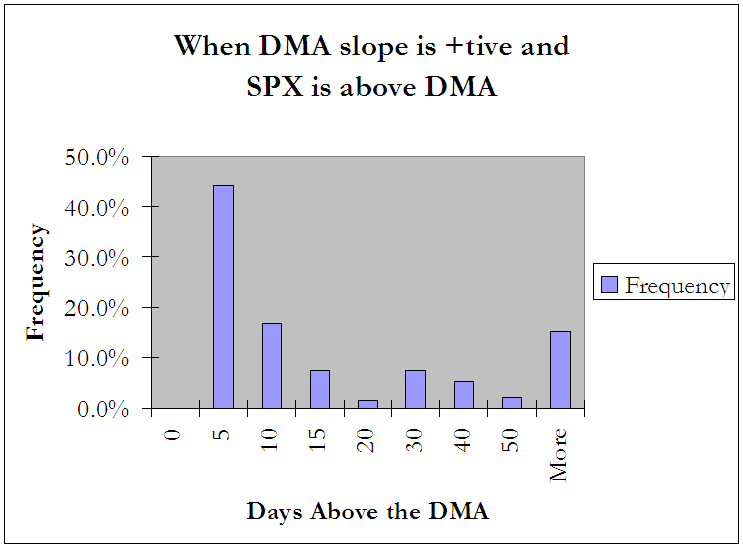Are We Myth-taken?
Are We Myth-taken?
by gmak
Calling the post “The Ides of March” is a bit too obvious, and will probably be used by hundreds of bloggers. I’m a contrarian by nature, so I want to avoid any apocalyptic predictions today.
“As goes January, so goes the year”. “Invest ’til May, then go away”. “The trend is your friend”. We’ve all heard these quoted at some time or another. Do these hold any water?
I crunched the SPX numbers from 1982 until now to check this out. I used the close from the last trading day of year(-1) to the close of the last trading day of year(0) for the annual returns. I used the last trading day in January to get the January returns (again from the last trading day of the previous year). I used from Sept 30 -> April 30 for the ‘invest until May’, and from April 30 -> Sept 30 for the ‘go away’. In each case, the myth held true 20 / 26 times (the 27th data point is 2010 which is not complete yet).
As Goes January…..
Notice in the table below, that January 2010 was a negative month. There are only 9 years out of 27 where this was the case. Half of them didn’t resolve, meaning that the myth works best for January with a positive return. Otherwise, it is a 50/50 proposition at best – which means a coin toss.
Invest ’til May….
When October – April inclusive has a gain, there are 3 / 17 years in which May – September inclusive is a greater gain. Note that there were only 3 years where May – Sept had a loss, when Oct – Apr had a gain. If Oct – Apr has a gain, it is worthwhile holding on, probability -wise. So far, SPX has about a 100 point gain since the close on Sep. 30, 2009.
When Oct – Apr is a losing period, May – Oct outperforms 4 / 7 times – all of them with gains. So it is safe to say that the loss part of the ‘invest ’til May’ myth is a coin toss as well.
| YEAR | As goes January | So goes the Year | 26 | 10 | Invest Until May | Then Go Away | 26 |
| 1982 | 20 | 20 | |||||
| 1983 | 3.3% | 17.3% | 1 | 36.5% | 1.0% | 1 | |
| 1984 | -0.9% | 1.4% | 0 | -3.6% | 3.8% | 0 | |
| 1985 | 7.4% | 26.3% | 1 | 8.3% | 1.3% | 1 | |
| 1986 | 0.2% | 14.6% | 1 | 29.3% | -1.8% | 1 | |
| 1987 | 13.2% | 2.0% | 1 | 24.7% | 11.6% | 1 | |
| 1988 | 4.0% | 12.4% | 1 | -18.8% | 4.0% | 0 | |
| 1989 | 7.1% | 27.3% | 1 | 13.9% | 12.8% | 1 | |
| 1990 | -6.9% | -6.6% | 1 | -5.3% | -7.5% | 1 | |
| 1991 | 4.2% | 26.3% | 1 | 22.6% | 3.3% | 1 | |
| 1992 | -2.0% | 4.5% | 0 | 7.0% | 0.7% | 1 | |
| 1993 | 0.7% | 7.1% | 1 | 5.4% | 4.3% | 1 | |
| 1994 | 3.3% | -1.5% | 0 | -1.7% | 2.6% | 0 | |
| 1995 | 2.4% | 34.1% | 1 | 11.2% | 13.5% | 0 | |
| 1996 | 3.3% | 20.3% | 1 | 11.9% | 5.1% | 1 | |
| 1997 | 6.1% | 31.0% | 1 | 16.6% | 18.2% | 0 | |
| 1998 | 1.0% | 26.7% | 1 | 17.4% | -8.5% | 1 | |
| 1999 | 4.1% | 19.5% | 1 | 31.3% | -3.9% | 1 | |
| 2000 | -5.1% | -10.1% | 1 | 13.2% | -1.1% | 1 | |
| 2001 | 3.5% | -13.0% | 0 | -13.0% | -16.7% | 1 | |
| 2002 | -1.6% | -23.4% | 1 | 3.5% | -24.3% | 1 | |
| 2003 | -2.7% | 26.4% | 0 | 12.5% | 8.6% | 1 | |
| 2004 | 1.7% | 9.0% | 1 | 11.2% | 0.7% | 1 | |
| 2005 | -2.5% | 3.0% | 0 | 3.8% | 6.2% | 0 | |
| 2006 | 2.5% | 13.6% | 1 | 6.7% | 1.9% | 1 | |
| 2007 | 1.4% | 3.5% | 1 | 11.0% | 3.0% | 1 | |
| 2008 | -6.1% | -38.5% | 1 | -9.2% | -15.8% | 1 | |
| 2009 | -8.6% | 23.5% | 0 | -25.2% | 21.1% | 0 | |
| 2010 | -3.7% |
Is the trend your friend? My response is: Which trend?
Monthly shows a move up from October 2009 – off of a lower trend line that seems to begin back in 2005. EUR has closed above the 55 Monthly MA, and above the 61.8% FIB (Not shown but from the high at 1.6038 in July 2009, to the low at 1.2330 in Oct. 2009).
The 10 month MA has crossed above the 21 MA (happened in December) – but they are both sloped down if that really means anything on this scale. OVerall trend = bullish for the EUR.
Monthly EUR:
http://www.uploadgeek.com/share-7AF4_4B9C3AE6.html
On the weekly scale, however, EUR stayed within the channel. The 10 and 21 Week MAs are in a bearish pattern. But TD Pressure is showing a low risk BUY that triggered last week. The FIB situation is the same for the monthly – here the label says 38.2% but it is the same line as the monthly 62.8%. This could be a possible turn up for EUR on a seekly basis – but a close above the channel is needed to confirm. As well, there is that pesky (red line) TD resistance between the latest bar and the 55 weekly MA. Looking back a ways to Dec 2008 and May 2009, it seems that if the 55 wMA acts as resistance – there is a sell off. If it is pierced and holds that this sets up the move up. Overall – could go either way.
Weekly EUR:
http://www.uploadgeek.com/share-1889_4B9C3CB6.html
Daily EUR has closed above the channel (is this some sort of scaling error?). As well, the 10 and 21 DMA have just crossed bullish – which is usually a sign for traders to go bullish. 1.3814 at the 50% FIB stands in the way of a continued move up – could there be a bounce down to re-test the channel top before moving up? Can anyone else see the wide and round J-Lo bottom forming? It’s usually a precursor to a move up.
But, TD pressure does look a little overbought and, unlike SPX, it does not stay up there long; usually 3 – 4 days max (occasionally as much as 8 days – but this is rare). The GS call for EUR = 1.45 is suspect in light of their analysis about a slowing Europe.
Daily EUR:
http://www.uploadgeek.com/share-A55B_4B9C3DCF.html
I found a chart at Jesses American cafe. It is the third one down the page. http://jessescrossroadscafe.blogspot.com/2010/0…
Inspired, I did my own Weekly and daily SPX chart. As you can see, weekly DXY bounced off of the 55 DMA and is still above the support level (dashed yellow line just below) from January. TD Pressure has signaled oversold, and when it crosses above – this can take place during the week – this will be a “low risk BUY” from the DeMark indicators.
Weekly DXY
http://www.uploadgeek.com/share-9CE2_4B9D5427.html
Within that context, I drew the same channel on the daily DXY and you can see that DXY put a pin below, came close to the purple “eyeball” support line. This support line has held up quite well over the last two months. As well, the 55DMA lies below at 79.12 with more support. The 10 and 21 DMA have just crossed bearish. Offsetting this is the TD Pressure that has (like the weekly) gone into oversold and it will only take a move back above the green line to signal a “low risk BUY”. This usually happens within 3 – 4 days max (like the EUR, who knew?).
Daily DXY
http://www.uploadgeek.com/share-4DDE_4B9D53B9.html
Again, I ask: Which Trend?
Summary:
Possibly a move up Sunday overnight to test the 50% FIB – a little back and forth – testing the top of the channel again, and then on tho the 55 DMA (yellow line) over the rest of the week. If not, then the weekly bar should close back below is channel. Still a few weeks left in the month for it to put in a higher high on its chart. It’s easier to play long here – but looking for the reversal in the short term.
Sound fair or far-fetched?
I keep looking at that FIB at 1.3746. On a 30 min EUR chart, there was a test of this level off of the ramp ffrom overnight on Thursday /Friday. Is this considered solid support – going into a weekend? The drive up afterwards was muted. Does this level need to be retested on the daily chart?
The Broken Clock
Lehman Brothers. Ernst and Young. Dick Fuld. Tim Geithner. Prostate tickle in prison orange. Tick. Tock. Tick. Tock.
EQUITY
Friday’s SPX bar was a ’43’. It followed a ’35’. One has to remember that there are 25 possible bar shapes, so any 2 bar combination should occur 1 / 625 (25 x 25) times, which is only 16 bps (0.16%). My data sample has 7038 data points, more or less, which means that each combination should occur about 11 times. This is not the case, but it may just be due to the fact that the sample since 1982 is not large enough. I’m not going to speculate on this, yet.
Anyhow, the ’35’ + ’43’ combination has occured only 6 times – or less than half of what would be expected. In that time, there were 2 x ’51’ = open near HOD, close near LOD; 2 x ’15’ = open near LOD, close near HOD; 1 x ’14’; and 1 x ’25’. The odds favour a day where the close will be above the open. Note that this does not reflect on where the open will be relative to Friday’s close. Just note that the trend is up still.
To trade intra-day, this suggests going long at the open. There is no better feeling that going long at the open and having Geronimo kick a little while later. heh.
What about the inter-day trade?
I wouldn’t go short here for a longer trade. If you are already short you might want to hedge beyond OPEX. I have no idea what will happen in an OPEX week – but the odds are hgiher of SPX staying above the 55 DMA than they are of it going lower.
SPX has spent a full 10 days above the 55 DMA. The SPX falls back below the DMA only 4% of the time in the next 4 days. Given that SPX has made it to 10 days, the odds are 4% / 40% = 10% that SPX will go below the 55DMA in the next week. The odds are 90% that SPX will stay above the 5DMA for longer. Please note that this does not necessarily mean the SPX will go up. It could go sideways and the 55DMA could come up to meet it, crossing from below.
Maybe using the two positive slopes (based on the last 10 closes), is getting too ‘cute’. If only the DMA slope being positive is considered, then there is a 19% chance that the SPX wll go below the 55DMA next week. There is an 80% chance that the SPX will stay above the 55 DMA beyond next week. Given that it has been there for 10 days already, there is a 77% chance that this will not happen for at least 10 trading days (2 more weeks). There is a 58% chance that SPX will not go below the 55DMA for at least another 20 trading days. This is based on data since 1961.
The piece de resistance is that there is a 39% probability that SPX will stay above the 55DMA for more than 40 more trading days. You can make of that what you will. That is a pretty fat tail. Too bad that being ‘above’ doesn’t mean that SPX is necessarily going up that whole time.
| Days Above | Frequency |
| 0 | 0.0% |
| 5 | 44.2% |
| 10 | 16.8% |
| 15 | 7.4% |
| 20 | 1.6% |
| 30 | 7.4% |
| 40 | 5.3% |
| 50 | 2.1% |
| More | 15.3% |
OVERNIGHT
DATA
Empire manufacturing; TIC flows; Industrial production, and Capacity Utilization. These are numbers that might just raise big money’s hair on the back of their necks if they don’t come in as expected. Notice that most of this data is expected to be unchanged. The TIC flows are expected to decline to $47.5 billion from $60.3 billion in December.

















